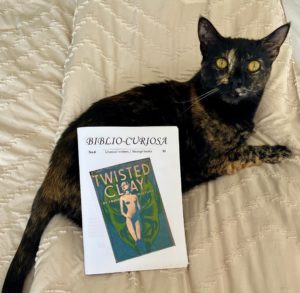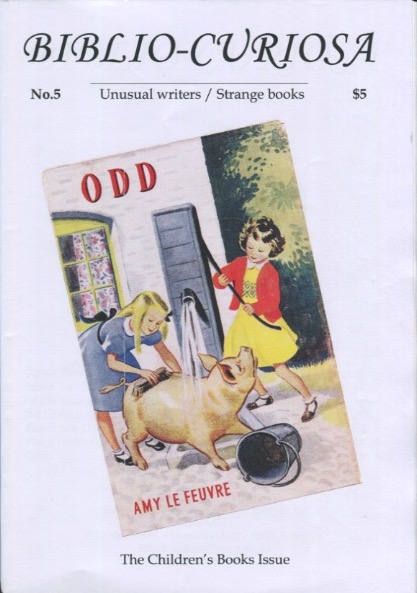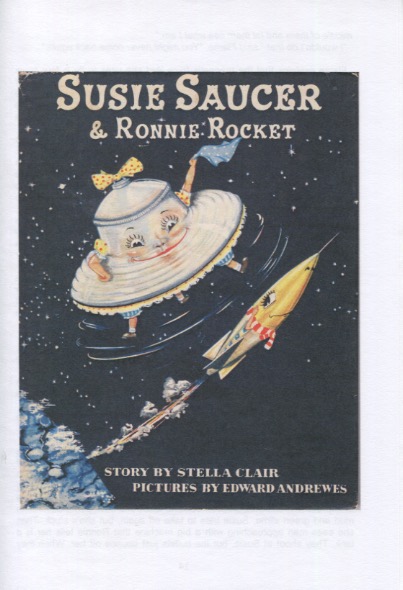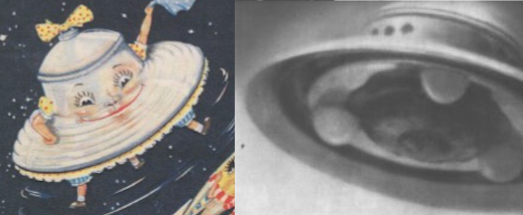There are a lot of reasons to read Chris Mikul’s work. He’s erudite and has a fondness for the strangeness that is the backbone of this site. He is able to look at terrible literature with a kind intellectualism that I would do well to emulate (there are a couple of books I eviscerated on this site that I want to revisit and see how they read with a more generous, less pedantic eye). He’s introduced me to some amazing books, not the least among them The Pepsi-Cola Addict by June Gibbons, which I’ve had in my possession for a while but have yet to read because I’ve wanted to read it for so long that I feel a weird sort of sorrow at the prospect of losing that feeling of joyful anticipation.
One of the best reasons to read him is his deep knowledge of writers who have more or less been lost to time. There are so many excellent and interesting books that for various reasons slip away from the public eye, and Mikul finds a lot of value in researching such books and the authors behind them. His articles that feature books that are lost or nearly lost to modern readers are fascinating, and at times maddening because I can seldom find copies of the books to read for myself.
There are five articles in Biblio-Curiosa No. 6, and I am limiting myself to the cover story, but bear in mind that the remaining four articles are very much worth reading, especially the analysis of William Nathan Stedman, a poet very much in the running for the worst poet ever. I’m discussing the cover piece exclusively because it is such an excellent example of Mikul’s research chops as well as his affection for the topic as he ferrets out information about forgotten authors and their works.
Few know the name Frank Walford these days, and that is a shame because his books were both ahead of their time in terms of content and because the content itself was often completely lunatic. Mikul’s article focuses on Twisted Clay, a delightfully batshit and sordid book about a psychopathic teenage lesbian. This book was initially published in 1933, and contains violence and sexual implication one does not expect to find in pre-WWII literature.

Twisted Clay is narrated by its protagonist, Jean Deslines. She lives in New South Wales with her father and grandmother. She is, as Mikul points out, “sexually precocious,” and at age twelve was already behaving in a very provocative manner, swimming nude in front of neighbors and attempting to seduce the clergyman her beleaguered grandmother asks to speak to her about her exhibitionism (and it sounds like she very nearly succeeded). Jean is primarily sexually attracted to women and sleeps with the housemaid Jenny, and one wonders how her grandmother felt about having two lesbians in her prim household. Later, Jean’s cousin Myrtle, herself a lesbian, tells Jean that she doesn’t like men so she will likely never marry. When Jean pushes her for more details, she tells the fourteen-year-old Jean to look it up.
Jean reads the sexual arbiters of the time (think Freud and Havelock Ellis) and realizes she is a lesbian and is so appalled by this information that she seeks out a boyfriend, sleeps with him and promptly becomes pregnant. Her father arranges an abortion but this does not change Jean much. In fact, she begins to dress in a manner meant to attract men, and it succeeds, because when her Uncle Harry and Aunt Gabrielle come to visit, Uncle Harry develops a sexual attraction to his young niece, a situation that drives her aunt to despair as she tries to make Jean aware of the situation. Jean toys with the woman, fully aware that her uncle wants to have sex with her, but pretends she doesn’t. When she finally feigns understanding, she immediately accuses her of having a dirty mind. When everyone comes to see what the matter is, Jean adds fuel to the already incendiary situation and her aunt and uncle leave the next day.
Jean’s father speaks to the family doctor, Dr Murray, and they discuss what needs to be done with Jean. Insanely, the doctor recommends that she receive a sort of ovary operation to encourage more feminine behavior, as well as psychotherapy. Jean is thrilled at the idea of psychotherapy because she can “mystify the operator by relating imaginary dreams and fictitious incidents!” She is less enthusiastic about the operation, thinking it would kill her personality and that she would be justified in killing her father in defense to avoid such a death. And this is how this strange girl tries to dissuade her father from forcing the surgery:
“Daddy!”
“Yes, Jean.”
“Dr. Murray said, if he owned me, he would thrash me. Why don’t you thrash me, to see if it should do any good?”
“Don’t be stupid. You’re too old to thrash.”
“I’m not, I’m not! See, here’s your walking stick. Beat me with it, beat me hard!”
“Go to bed, child, and don’t talk nonsense.”
With a quick jerk, I stripped off my pyjama trousers, standing before him nude to mid-thighs, clad only in my dangling pyjama coat. “Beat me, Daddy, beat me hard, beat me till the blood flows. I want you to.”
Okay, so by now it should not surprise anyone that some of Frank Walford’s books got banned and that this book is unlikely to end well for anyone involved.
To avoid going to Europe for the surgery, Jean fakes interest in a grave site in which someone will be buried later that day. Jean’s father takes her to see the grave and she takes him out with a hatchet to the head and pushes him into the grave. But this was a “from the frying pan into the fire” sort of situation because Dr. Murray is given guardianship of her. Jean, once again with her back against the wall, decides to set up Dr. Murray. She senses he is attracted to her so she tries to seduce him and arranges for a policeman to see the good doctor throw himself at her. Alone finally, her father’s ghost appears to her telling her no hard feelings for killing him, but later she hears a voice that tells her she must go to the grave, dig her father up and wrap up his broken skull. She does so but realizes that she didn’t secure her father’s corpse, which could implicate her, so she pretends that she dug her father up because she had overheard Dr. Murray murmur something about killing him. This causes the town to consider Jean a heroine but the voice again speaks up, wanting her to return to bind his wounds a second time. This time Jean’s luck runs out and the police catch her in the act and arrest her. (The plot makes perfect sense if you don’t think about it.)
Sent to a mental asylum, she escapes and turns to prostitution to support herself. She is disgusted by the men she sleeps with but earns a lot of money. Later the voice comes back and tells her to start killing the men who lust after her, and yet again she does what the voice tells her. She runs into cousin Myrtle again, they resume their sexual relationship, but the voice tells her to kill Myrtle, too, and she obliges. Later Jean opens a beauty salon and a gangster takes a shine to her and wants her to join his criminal pursuits. She does and later finds that she is attracted to the gangster and becomes a sort of moll. Life is going as well as it can when one of the policemen who arrested her for killing her father sees her, follows her and manages to get a sample of Jean’s fingerprints. She kills the police officer, but this last murder has her feeling contemplative. She muses about suicide:
Life was not so attractive that I desired to cling to it like a limpet to its rock. I had tasted almost everything but death. Should I…? Why not?
Why not indeed? I leave the reader to wonder what she ultimately does.
This book sounds like a hoot, but the fact that the author was a hoot as well is the icing on the odd cake. Frank Walford was born in Australia in 1882. He was a gifted amateur boxer who could have gone pro had a horse not kicked him in the face, breaking his cheekbones and knocking out a few front teeth. He then decided to purchase a boat and traveled along the Australian coastline and three months later came back to land but the rough company he kept caused him to lose a job with a bank. He then returned to sailing again, and made money fishing and shooting crocodiles. (It’s right about here I need to mention that I am not making any of this up.)
Walton was pretty good with a knife and gun and got to prove his mettle with a knife after a man with a grudge stabbed him in the back, right in his kidney. After he recovered, he challenged the man to a knife fight and severed the tendons in his elbows, ensuring the man would never again stab a man in the back.
He eventually married and had children and began to write. He became involved with a group of writers who called themselves the Blue Mountaineers. Interestingly, the only other member of the group who had some success writing penned a novel that featured an atypical heroine who thinks about suicide when life got too boring. His novel Silver Girl sounds absolutely lunatic. It features a passage wherein a side character realizes his wife gave birth to the protagonist’s child. When the protagonist comes to visit with his new wife, the side character grabs the infant and uses it as cudgel to beat the protagonist’s wife to death.
During WWII, Walford served in the Voluntary Defense Corps and became an avid anti-Communist and continued to write. Mikul observes that it is very difficult to summarize Walford’s style.
He could be coarse…, morbid and willfully perverse, but when he chose to, he could write with great sensitivity and feeling. He had a journalist’s eye for detail, and the settings for his stories are always vividly imagined, no matter how wild the plots became.
I can’t help but marvel that Walford’s work was published, especially Twisted Clay. He really was pushing boundaries, and even now, it seems very likely social media would have come for him and cancelled him had his books been released today. I’ll probably spend the weekend looking for copies of his books and pray they are affordable if I find any.
Check back tomorrow for another Mikul ‘zine before I pivot back to non-Mikul content. Should you decide to purchase a copy, contact Chris at chris.mikul88@gmail.com.
ETA: Holy crap, it turns out that Amazon carries Twisted Clay!



